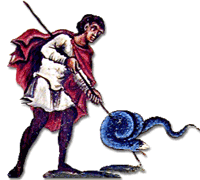The Physiologus is a collection of moralized beast tales. It was one of the most popular books of the Middle Ages, appearing in most of the vernacular languages of Europe, as well as Greek (its original language) and Latin. It was the basis of the later bestiaries, which added to the stock of stories and to the moralizations. Many versions of it were written by a variety of authors, both in prose and in verse; some left off the moralizations, while others expanded on them.
Origin and Evolution of the Text
It is most unlikely that Epiphanius wrote the Greek Physiologus, though he may have known of it. Since the true author was unknown, several Greek and Latin Christian church writers besides Epiphanius received credit for it in the Middle Ages, including Peter of Alexandria, Basil, John Chrysostom, Athanasius, Ambrose, and Jerome; even pre-Christian authors like Solomon and Aristotle were said to have written parts of it (Curley, p. xvi).
When and where it was written is also uncertain, though the general consensus is that it was probably produced in Alexandria, sometime in the third or fourth century. The date is based on evidence in the text itself and on references to the text by other writers by the fifth century at the latest; the place is suggested by the animals described, several of which were known primarily in Egypt.
The original Greek text contained between 40 and 48 chapters. No manuscript copies of the original Greek text survive; the earliest versions of the text are Latin translations. Through the centuries the number of chapters was expanded; some medieval bestiaries have well over a hundred chapters. The animals described also changed as some were added and others discarded. The works of later authors, such as the sixth-seventh century bishop Isidore of Seville and the work of other authors of the encyclopedic texts that were popular in the Middle Ages, were merged with the Physiologus; the result was the medieval bestiary of the twelfth and thirteenth centuries. The original prose was also turned into poetry in Anglo-Norman French and other vernacular languages.
The Meaning of the Name "Physiologus"
"Physiologus" is often translated as "the naturalist," but this is somewhat misleading. The Physiologus is not "natural history" in the same way that, for example, Pliny the Elder's first century work Natural History or Aristotle's De animalium is. The intent of those authors was to describe what was known about "nature" at the time; to disseminate objective knowledge. The author of the Physiologus used some of the descriptions of animals found in the earlier works, but his intent was different: the stories were there to illustrate the deeper meaning, the explicitly Christian religious, dogmatic, allegorical meaning, that was thought to be imbedded in nature. "Physiologus was never intended to be a treatise on natural history. ... Nor did the word φυσιολογος ever mean simply "the naturalist" as we understand the term, ... but one who interpreted metaphysically, morally, and, finally, mystically the trancendent signficance of the natural world." (Curley, p. xv).

Illustrations
Although the original Greek Physiologus was probably not illustrated, later Latin versions of it commonly were. The Latin "Bern Physiologus" (Burgerbibliothek Bern, Codex Bongarsianus 318) of the ninth century is one of the earliest extant illustrated Physiologus manuscripts (the illustration at right is of the fourth property of the serpent from folio 12v). The later bestiaries were usually illustrated, often very luxuriously; the Aberdeen Bestiary is a good example.
Manuscript Sources
Ponce de Leon appears to have taken (at least in part) the Physiologus attributed to Epiphanius from manuscript Grec 834, now in the Bibliothèque Nationale de France, Paris. This manuscript was copied around 1585, and is "one of the most beautifully illuminated Greek [Physiologus] manuscripts..." (McCulloch, p. 15, note 1). In his Praefatio Ponce de Leon states that he used three manuscripts from Italian libraries.
